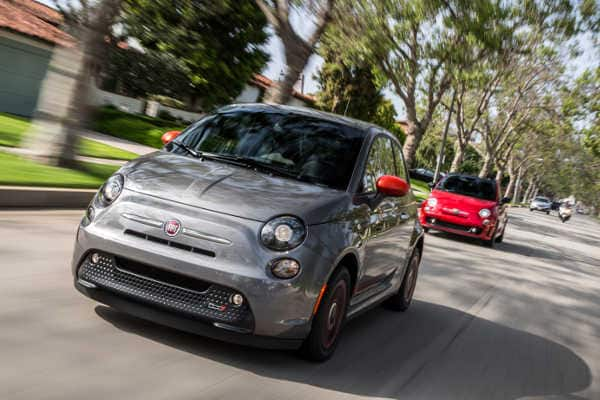All photos courtesy of vehicle manufacturers
Electric cars may be the “greenest” automobiles you can buy, but you may need some extra green from your wallet to cover their insurance costs, according to a new Insure.com analysis.
Insure.com reviewed five popular electric vehicles (EVs) and found that they cost 15.5 percent more per year on average to insure than their gas-powered cousins. That’s on top of the roughly $10,000 to $15,000 higher base prices you’ll face for an EV versus a traditional car (though most EVs qualify for $7,500 federal tax credits that soften the blow).
“It’s very counterintuitive, because an electric motor has fewer moving parts than an internal-combustion engine does,” says Eric Ibarra, Kelley Blue Book’s director of residual-value consulting. “But insurance companies have a lot of statisticians who chunk through the numbers and decide what to charge for each model.”
Ibarra says EVs cost more to cover because their hefty sticker prices and expensive batteries mean car insurance companies face big losses for accidents or thefts involving them.
“The batteries cost a lot, and EVs are expensive to produce,” he says.
The silver lining of going green
But Ibarra adds that electric cars have such big subsidies and great fuel efficiency that consumers can still make out like eco-bandits by buying them.
To begin, most offer the equivalent of at least 100 miles per gallon equivalent (or “MPGe”), the U.S. Environmental Protection Agency’s measure of electric vehicles’ fuel efficiency. Add in perks like a California law that lets EV drivers use HOV lanes with only one person in the car and Ibarra says electric vehicles make sense for the right consumers.
“If you have a 50-mile commute each way, then an electric vehicle probably won’t work for you,” he says. “But if you’ve got a 10-mile commute, live in the city and aren’t on the freeways a lot, they can work out great.”
Here are a few models that come in both electric and gas-powered versions, ranked in order of their disparities in insurance costs.
 1. Fiat 500e vs. Fiat 500 Pop (automatic transmission)
1. Fiat 500e vs. Fiat 500 Pop (automatic transmission)
Premium difference: 27.3 percent
This little Fiat combines cute looks with city-friendly handling and parking, as well as incredible fuel efficiency if you buy the electric-powered 500e version.
The EV model gets 122 MPGe/city and 108 MPGe/highway, with an 87-mile range between charges and four-hour recharging time. But you’ll have to pay big bucks for the little electric car, as the 500e starts at $31,800 and averages $1,682.20 a year to insure.
That’s way more than the $18,195 list price and $1,321.32 annual premiums you’ll face with a gas-powered, automatic-transmission Fiat 500 Pop, which gets great fuel efficiency for a non-EV — 31 mpg/city and 40 mpg/highway.
Ibarra says both versions offer such good looks and fuel economy that either is “great for people who want to make a statement about their love of style and their love of the environment.” But he notes that even the 500 Pop costs a lot for a car of its size. You can buy a larger model like the Chevrolet Cruze compact sedan for less ($16,170).
 2. Chevrolet Spark EV 1LT vs. Chevrolet Spark 1LT
2. Chevrolet Spark EV 1LT vs. Chevrolet Spark 1LT
Premium difference: 20.1 percent
Despite its name, the Spark comes in both electric and gas-powered versions. There are big differences in both fuel efficiency and insurance costs between the two.
The Spark EV 1LT gets 128 MPGe/city and 109 MPGe/highway and can go 82 miles in between charge-ups, although recharges take seven hours or so.
This electric car lists for $25,170 and costs $1,457.97 a year to cover — well above what you’d pay for a comparable gas-powered Spark 1LT with an automatic transmission. That vehicle costs only $15,095 to buy and $1,214.43 per year to insure. But it gets 31 mpg/city and 39 mpg/highway — excellent numbers for a gas-powered car, but nowhere near what the Spark EV offers.
Still, Ibarra says you really can’t go wrong with either car. “The Spark EV is a good vehicle, and the gas-powered version is good as well,” he says.
QuickTake
 3. Ford Focus Electric vs. Ford Focus Titanium Hatchback
3. Ford Focus Electric vs. Ford Focus Titanium Hatchback
Premium difference: 13.4 percent
The Ford Focus Electric is a rarity among EVs in that it’s a compact car rather than a subcompact. But its price tag and insurance premiums match its larger size.
The EV starts at $29,170 and costs an average of $1,579.30 per year to insure, although it offers an excellent 110 MPGe/city and 99 MPGe/highway. The model can go about 76 miles between recharges, which take about four hours.
By comparison, the gas-powered Focus Titanium Hatchback gets 27 mpg/city and 40 mpg/highway. Again, that’s good for a traditional car, but nowhere near EV levels.
On the other hand, the Focus Titanium costs $1,392.07 a year to insure and lists for $23,670.
Ibarra gives both versions a thumbs-up. “The Focus is an example of something that might surprise lots of people — a Detroit automaker producing a great small car.”
 4. Smart Fortwo EV Coupe vs. Smart Fortwo Passion Hatchback
4. Smart Fortwo EV Coupe vs. Smart Fortwo Passion Hatchback
Premium difference: 13 percent
This tiny two-seater offers cute looks, the ability to fit into almost any parking space and a fantastic 122 MPGe/city and 93 MPGe/highway when you spring for the electric version. It’s also the lowest-priced 2015 EV on the U.S. market.
On the downside, the electric car can go just 68 miles between charges and takes about six hours to fully juice up. The model also costs more to buy and insure than a gas-powered Fortwo Passion Hatchback.
Expect to spend $25,000 for the EV Coupe versus just $14,930 for the Passion Hatchback, as well as $1,382.84 a year to insure the electric version compared to $1,224.27 for the gas-powered one.
Of course, the Passion Hatchback gets just 34 mpg/city and 38 mpg/highway. Ibarra says both versions also suffer from “a less-than-great ride” and cost a pretty penny given their small size and various shortcomings — short range and long recharge times for the EV, and so-so fuel efficiency for the gas-burning version.
 5. Volkswagen e-Golf SEL Premium vs. Volkswagen Golf SEL
5. Volkswagen e-Golf SEL Premium vs. Volkswagen Golf SEL
Premium difference: 3.9 percent
You can hardly go wrong with either the gas-powered or electric Golf, as Motor Trend recently named both vehicles (along with the diesel Golf TDI) as its 2015 Car of the Year.
The e-Golf offers 126 MPGe/city and 105 MPGe/highway, along with a respectable 82-mile range between charges and around a four-hour recharging time.
That said, you should plan on spending $35,445 to buy an e-Golf SEL Premium and $1,462.15 a year to insure it. That’s noticeably more than the $27,395 base price and $1,407.41 annual premium you’ll face for the gas-powered Golf SEL, which the EPA rates at 25 mpg/city and 36 mpg/highway.
A cost you won’t see at the showroom
Electric cars aren’t the only vehicles with premiums that may surprise buyers, says Robert Beaupre, managing editor of Insure.com.
“It’s hard to tell how much a vehicle will cost to insure by looking at it — or even looking at its specifications,” says Beaupre. “In addition to your personal factors, insurance companies price rates based on how much they’ve paid out in claims for that vehicle model in the past. Unless you work at an insurance company, that data is hard to find.”
Beaupre adds that if you’d like to compare rates among new models you’re considering for purchase, you can visit the Insure.com feature on average car insurance rates by model, which features rate data on more than 1,500 2015 vehicles.






